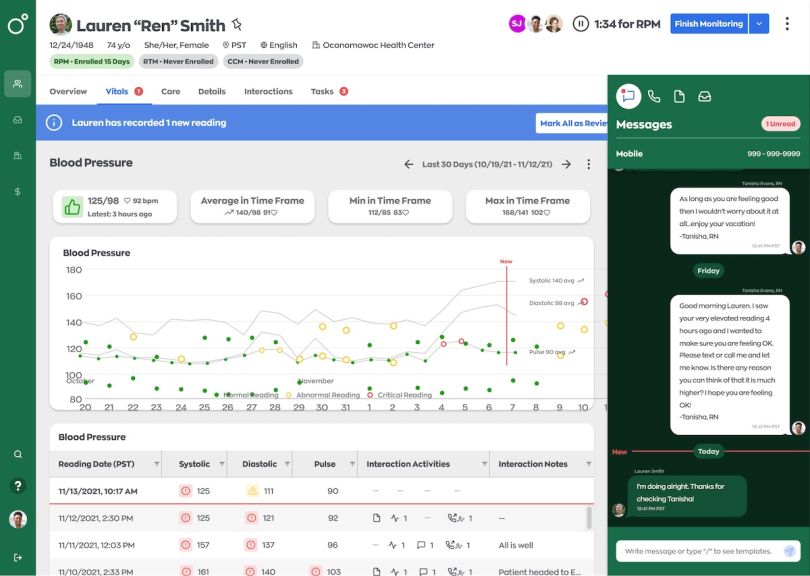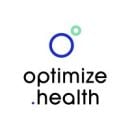Over the last 10 years, remote patient monitoring (RPM), a type of remote care program that allows healthcare providers to view their patients’ real-time health data, has been on the rise. The pandemic further propelled remote care adoption, with RPM claims jumping by nearly 1,300 percent between January 2019 and December 2022 according to a February report by Definitive Healthcare.
Optimize Health is on the forefront of such care. Its latest solution allows doctors to monitor their patients’ vitals from afar and centralizes multiple care programs into one technology solution. This platform is an evolution of their previous solution, which was only focused on RPM. After listening to providers’ needs, they understood that doctors sought more capabilities and a centralized system for all remote care programs, including a solution for chronic care management (CCM) to provide extra support and care coordination to patients with hypertension, diabetes, COPD, obesity and more.
“To address our client's needs and the market shifts, we embarked on a redesign of our entire platform to evolve Optimize Health from a RPM-only company to a remote care company that offers the ability to treat patients across remote care programs in a single solution,” said Allison Card, Optimize Health’s senior director of product.
What Gets You Out of Bed in the Morning?
Card leads Optimize Health’s product and UX design teams that come together over their mutual passion for improving lives. “We wake up every day thinking about how we can make our product better for our users and ultimately help patients improve their chronic conditions, stay out of the hospital and get the support they need to manage their health and well-being,” Card said.
From the start, the redesign was a collaborative effort — the process required involvement from product, design, engineering, customer success, technical support, marketing, sales, finance, legal and operations departments.
Card, who led the process, asked team members from each function to write down what they thought needed to happen to successfully launch a singular remote care solution. Those thoughts became the official Product Launch Plan, which covered everything from training the implementation team to rewriting legal disclaimers.
Weekly stakeholder meetings ensured all involved felt excited and on track to deliver. Client buy-in was essential, too. Product innovation meetings allowed key client to share their perspectives and feedback on the new features.
The redesign process was quick. In just 18 two-week Agile scrum cycles (just over eight months), the cross-functional team launched the pilot of the redesigned product.
“It was a truly incredible feat made possible by our awesome team,” said Card, who sat down with Built In to explain more about the product development and launch.
What tools or technologies did your team use to build the product?
We needed to complete the entire redesign in less than one year, so we decided to focus our efforts on core intellectual property — the features that made Optimize Health special when it came to remote care. We decided to use world-class technology for the rest. For example, there was no need for us to reinvent authentication or search, so we used tools like Auth0 and Algolia. Then we focused engineering time and effort on building out the true secret sauce of remote care.
We wanted our solution to be fast, measurable and surround our users in support, so we invested in tools like AWS, Snowflake and continuous deployment pipelines. We integrated LaunchDarkly and Pendo to enable feature flagging and A/B testing. We integrated a combination of Zendesk and LogRocket so we know exactly where our users are struggling and why.

What obstacles did you encounter along the way? How did you successfully overcome them?
It’s impossible to get everything right for launch day. No matter how deeply you think about and investigate requirements, no matter how much user testing you do and no matter how many stakeholder sessions you hold, there will be something missing. Knowing this, we broke the project into five milestones to tackle different sections of the application. At the end of each, we completed user testing and celebrated our success.
The final milestone was our pilot. This is when we planned to tackle the unknown unknowns: Everything we would learn when clients used the redesigned product that we had no idea about during development. To make this a success, we needed clients who were willing to pilot a product that might not be perfect on day one but who were excited to support us through our journey.
We found our first two clients inside the company. Optimize Health has an incredible clinical staff who support and act as an extension of our clients. We put together a pilot program with these nurses and clients who manage their own programs. The product and engineering teams spent two months watching them use the redesigned product, fixing bugs and addressing gaps in user needs. At the end of the pilot period, we launched the generally available version of our product with confidence.
“We want to build products that are specifically designed for clinical environments and help nurses, clinical staff, doctors, billers and program managers solve the core problems they face in their day-to-day lives.”
When you think of other companies in your industry, how does Optimize Health compare when it comes to how you build and launch new products?
Our product and engineering teams are hyperfocused on user-centered design. We want to build products that are specifically designed for clinical environments and help nurses, clinical staff, doctors, billers and program managers solve the core problems they face in their day-to-day lives. We want them to spend their time focusing on patient care, not on fiddling around with technology or navigating clunky workflows.
A lot of remote patient monitoring or remote care companies throw together a product that just barely meets the Centers for Medicare & Medicaid Services guidelines to bill for various Current Procedural Terminology (CPT) codes. These cheap solutions might be appealing at first, but we hear from clients who left those solutions and came to us that those tools shifted the burden to their nurses and clinical staff who have to navigate an unwieldy product to deliver patient care.
At Optimize Health, we put new features through multiple rounds of testing including card sorting, task-based user interviews, stakeholder sessions, user acceptance testing, pilots and A/B testing. We also shadow our users on a regular basis to understand their clinical workflows and identify opportunities to improve the product for all users, from ordering physicians, nurses, and even their billing staff. We are incredibly proud of the products we deliver and our users love our remote care platform. One of them even told us, “It’s the Ferrari of remote care platforms.”






